|
A glimpse into the past...
|
ALLENDER'S STEAM SWING
OR MERRY-GO-ROUND
The first
steam (coal burning) merry-go-round in the state of Iowa was owned and
operated by the Harrison Allender family of near Keota. The Allender
home was 2 3/4 mi. northeast of Keota where they had built a special
shed for the merry-go-round. Prior to the steam powered merry-goround
the Allenders had a horse powered merry-go-round.
In 1892
"the Allenders' Steam Carousal is the delight and admiration of our
people and is having a mammoth business. It plays Dixie, Mocking Bird
and Ta-ra-ra-boom."
The
carousal operated at celebrations far and near, being a big attraction.
By 19I2 Mr.
Allender got his dynamo going using the old steam engine for power.
When they came to a town that did not have an electric light system,
they could go right ahead just the same.
Quoting
from The Keota Eagle of August 17, 1916: Harrison Allender's
merry-go-round that has been part and parcel of our existence for
nearly 25 years, has been sold and it was shipped to Brannon, Iowa.
It's like saying goodbye to an old friend.
|
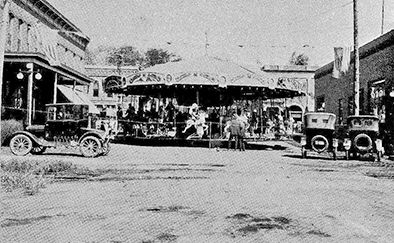
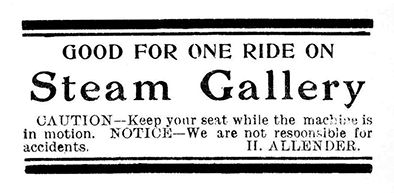
Ticket used on Allender's Steam Swing. |

Allender's Steam Powered Merry-Go-Round operating
South of
the Commercial Hotel near R.R. tracks. |
A
SENSATION IN KEOTA
October 18,
1928. Mrs. Sara Burns says that more than 40 years ago (around 1888) a
colored woman named Mrs. Davenport moved to Keota and occupied a house
on Broadway in east Keota. The woman has been deserted by her husband.
She had a son about 4 years old. A few months after arrival here she
became mother of a baby daughter, who was the first colored child born
here. Dr. R. S. Brice was attending physician and she and Mrs. Charles
Hinman were called in to be of whatever assistance they could. The
woman was a hair-dresser and also worked out by the day. She worked in
many homes and lived here perhaps two or three years. The baby was a
sensation in the town for a while, just as Dorothy Mae Jones has been
the past two weeks here in Keota. She was born to Mr. and Mrs. Columbus
Jones at her home in Keota October 5. Dr. Hinsdill was the attending
physician. Dorothy Mae has two sisters, the elder of whom, Bernice, is
in first grade in school. The father is one of the paving workers.
Another
baby that was a sensation here for a while was the Mexican baby born
here about ten years ago to a couple that lived in a freight car on the
right-of-way, the father being employed by Rock Island.
These facts
will make interesting items in some future history of the town of
Keota. We like to get them into print so they can be preserved in the
files of The Eagle where some historian will sometime look for
information.
|
111

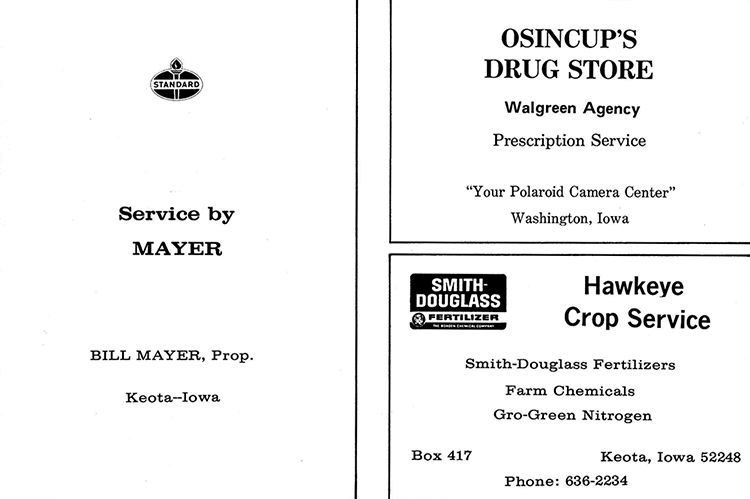
112
A glimpse into the past...
|
TRAIN WRECKS
August 22,
1907. Engine No. 338 arrived from Oskaloosa last Friday morning with
six cars of coal shortly after 7 o'clock, passing our section men at
the mile crossing west of town. The train crew set out all their cars
at Keota and started on their way back to Oskaloosa, for another train,
the engine going backwards and pulling their caboose. Foreman Kite
supposed the train's destination was Washington and they were pumping
down the track two miles west, when suddenly they discovered a train
almost upon them. Engineer Thomas Allen had seen the men and was
whistling and doing his best to stop, but the rail was wet that morning
and noise of the hand car prevented the men from hearing the whistle in
time. They hustled and had the hand car turned half way 'round when the
engine struck them at about ten miles an hour. The hand car raised the
tender, the rails spread, and over the engine went on its side burying
the hand car. Kite and one man had stayed with the car to the last. The
fireman jumped, but Allen stayed with his engine until all motion
stopped, put out the fire and climbed out the cab window which was then
on top. One truck of the caboose was derailed but the local freight
engine soon pulled it back on the track. Foreman Smithers of West
Chester and Crooks of Harper soon arrived with their men and by noon
had a track built around the dead engine so trains could pass. A relief
train came from Knoxville about 2 o'clock but didn't have the right
equipment so went back home. Roadmaster Lee came down that night to
look things over and decided to wait until Sunday to raise the engine
as there would be but one train to bother them that day. On Sunday a
train load of men came and by 4 o'clock they had the engine back on the
track, having separated it from the tender. The engine isn't damaged a
great deal. They also raised the tender that evening. They think no one
will be greatly blamed for the wreck.
|
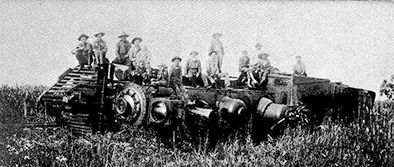
Sept. 22,
1910. The local freight from the west dropped a broken beam across the
track on the high level between Keota and Clear Creek fill. The express
from the west, following the freight, struck the beam and every wheel
on the train went off the track. Conductor George McDowell told
headquarters he could get the train back on the rails in three hours
which he did.
|
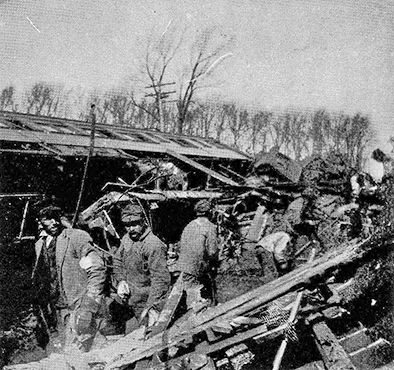 |
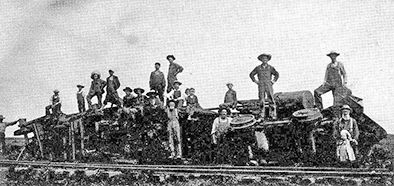 |

1910—1 Mile West of Keota. |
113
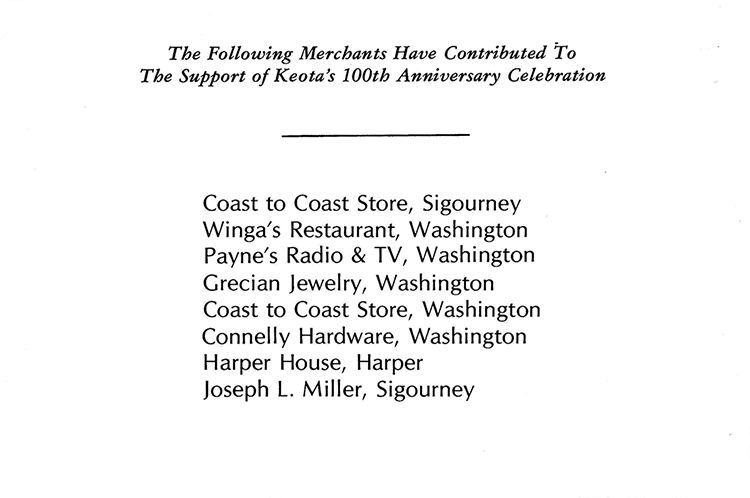
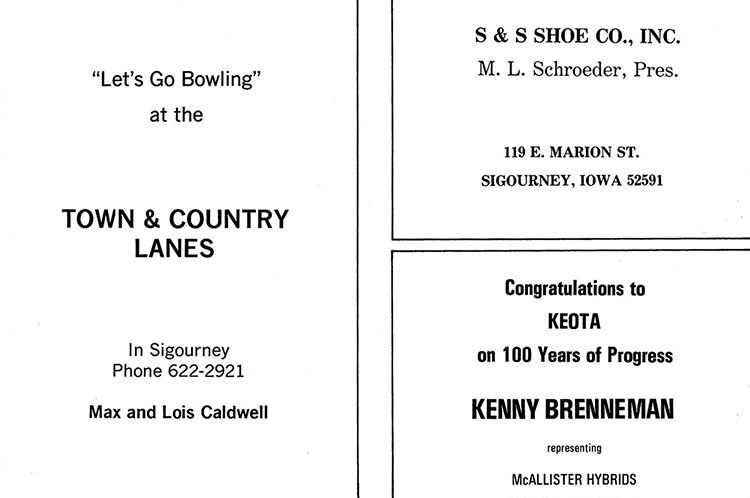
114
A glimpse into the past...
|
SEWERAGE AND DISPOSAL PLANT
December
l9, 1914. C. E. Hughes of Rock Island was awarded the sewerage contract
for $15,996.50 and the Offerman Construction Company of S. Omaha,
Nebraska, will build the septic tank and outlet for $8,789.35. The work
is to be completed by December l, 1915.
March 11,
1915. Contractor C. E. Hughes and his men began work on the sewerage
system on South Davis Street. As fast as the machine digs the ditch,
workmen lay the l2-inch tile and another machine fills up the ditch.
From South David street to disposal plant 15 inch tile will be used.
July 8,
1915. Mr. J. B. Offerman of S. Omaha, Nebraska, started to work on
disposal plant for the new sewerage system. They erected a shed and
have everything in readiness when the machinery arrives. The plant will
be located in a field south of town.
The
disposal plant was completed October 23 and required more work than
planned. The main tank is 30 x 100 feet and about 15 feet deep. The
plant needs but little attention and the final cost was around $9,000.
Engineer J. F. Sproate was general superintendent and overseerer and
has been here all summer.
October 19,
1916. The sewage system is now ready to be tested. The engineers have
checked it and the council has gone down into the manholes and looked
at 'em. They say it is all right and as soon as pumping apparatus at
the new station is installed it will be ready for the test.
|
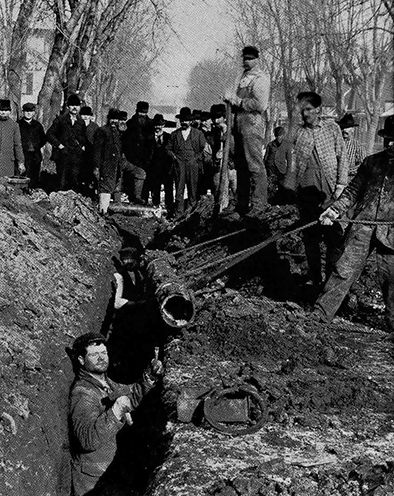
Laying Sewer Pipe in Keota |

Laying Sewer Pipe - Corner of Fulton and Broadway, Before 1904. |
115
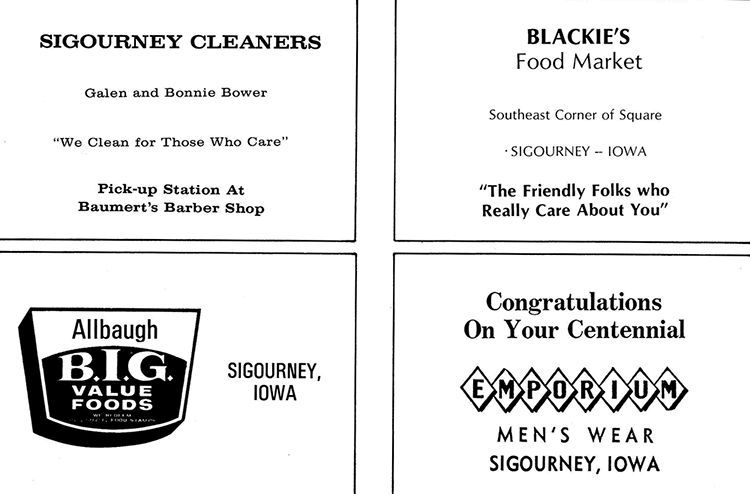

116
A glimpse into the past...
KEOTA'S
TELEPHONE STORY
The Keota
Telephone Company, known as the People's Telephone Company, was
originated by the Dupuis Family in 1898, when Thomas Dupuis, Sr. &
Sons, Thomas and Fred of Washington came to Keota and obtained a
franchise. The family had come from Chicago to Washington several years
earlier where Thomas, Sr. and two partners established the Washington
Exchange, selling out there in 1898.
Mr. Thomas
Dupuis, Sr., when but 14 years of age learned the telegraph business in
Chicago. While a resident of Chicago he was connected with the Rock
Island Railroad Company until 1882. From that date until 1887 he was
General Foreman of construction for the Chicago Telephone Company. Mr.
Dupuis was always quite familiar with Chicago history, especially that
part of it relative to the great fire of 1872. He lived within one
block of and bore the acquaintance of the woman whose cow kicked over
the lantern, causing the great disaster.
The Dupuis family
group of T. J. and Fred owned the Sigourney and Keota telephone
exchanges. The Dupuis' sisters, Mrs. Minnie Stewart and Mrs. l.aura
Smock, were active in the management of the Keota Telephone Company, as
also was another brother, Henry, until his death.
The telephone
exchange was first located in the Eaton & Holmes Drug Store.
February 1900 it was moved to a room upstairs in the Charlton Block.
The People's
Telephone Company was one of the oidest businesses in Keota and also
one of the few remaining in the same ownership for close to 50 years,
when the company was sold to the Central Iowa Telephone Company in 1952.
This company
changed to the dial system in 1956. The Central Iowa Telephone Company
made this latest improvement in the Keota Exchange in which it had an
investment of approximately $250,000.
The location of
the Keota Exchange was changed to the downstairs building, formerly
occupied by the Hitchcock Shoe Repair Shop, on the south side of
Broadway. All trouble and long distance calls are handled by the
Oskaloosa Exchange.
An efficient fire
alarm system has been set up in Keota. The company has installed 10
fire phones at locations where someone will always be in attendance at
some of the phones. The phones receive calls only, and have no dial to
make outside calls. Dialing 2345 rings all 10 phones. On receiving a
fire call the first fireman to reach the station will blow the siren.
The General
Telephone Company Of The Midwest bought out The Central Iowa Telephone
Company on April l, 1967.
MORE
ABOUT KEOTA'S TELEPHONE STORY
June 8, 1899. The
switchboard for the telephone exchange came and is to be seen at Eaton
& Holmes. Their City Drug Store will be "Central" and a young lady
will be stationed there to attend to the switch. It has a present
capacity of 50 phones.
July 27, 1899.
Miss Minnie Dupuis of Washington is acting as "Hello" girl pro tem at
"central" until some local party can master the intricasies of the
phone exchange.
July 27, 1899.
The telephone exchange was completed. Keota may now whisper into the
ear of Washington or Sigourney at will. Soon we can chin-chin to any
neighboring town at will over the wires.
September 7,
1899. A private telephone line has been put in from Keota to the C. F.
Singmaster place by Dupuis & Son at Singmaster's expense. This
entire community will eventually be bound together by telephone.
Wonderful, isn't it!
**********

In 1901 the
farmers started building their own telephone lines. Poles were set,
wires strung and telephones bought.
They owned the
lines themselves and got the benefit of the Keota Exchange at a
trifling cost. These were called mutual lines. Some of the lines
connecting to the Keota Exchange were the 76 line, the Valley Farmer's
Line, Wellman-Nira Line, Hawkeye Lines, East Farmer's Line,
Keota-Kinross Line, Talleyrand-Valley-Richland (or Singmaster) Line,
The "Kramer Line," Clear Creek Line, a line of 17 farmers southwest of
Keota known as "Montgomery Ward Line" having bought their phones of
that firm.
An organization
of all the mutual telephone lines running into Keota was known as the
"Keota Mutual Telephone Union." Constitution and by laws were adopted
and a delegate from each line named to represent his line at regular
meetings to be held in Keota.
These Mutual
Lines were eventually bought up by the Central Iowa Telephone Company,
by R. B. Soland.
July 23, 1903.
The local telephone exchange has been giving daily weather reports
since July l, between 10 and l1 o'clock a.m. Central gives a general
ring and everybody takes the receiver and hears the weather report.
July 2, 1925. The
Keota Telephone Company is putting in 3500 feet of conduits underground
on Broadway. Cable will be used from one end of town to the other. A
distance of one mile will be put underground. The business houses and
residences on both sides of Broadway will be connected from the alleys
and telephone poles on Broadway will be done away with.
117
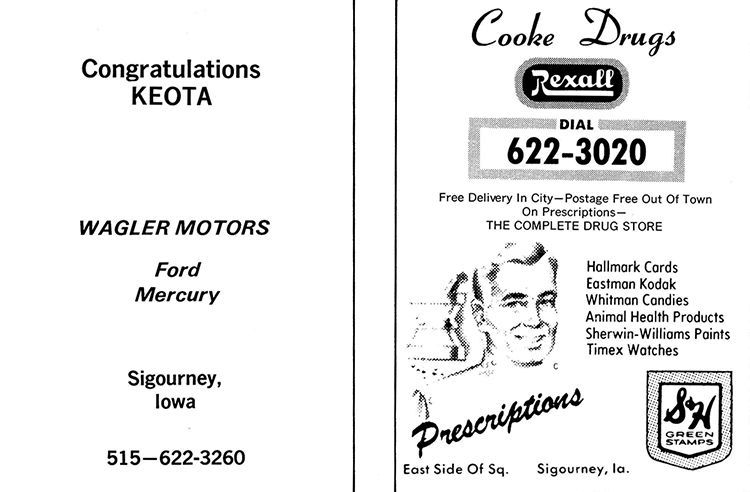

118
A glimpse into the
past...
HISTORY OF
KEOTA'S CITY WATERWORKS
July 25, 1949. In
regard to the establishment of the Keota waterworks an Eagle reporter
has pored through The Eagle files of the period of 50 years ago and
noted the followilng data therefrom in chronological order:
August 10, 1894.
Arch Stewart completed drilling for water in W. Broadway at a depth of
100 feet. The new supply of water seems inexhaustible. They are now
putting up the tower and pump. East Broadway is now thinking of putting
in a much better outfit. Later a hole was drilled on East Broadway at a
depth of 150 feet. Mains will be laid from tank to principal business
places on Broadway and Keota is now supplied with water.
May 5, 1898.
Mayor O. B. Jones received a petition of citizens asking a special
election on a waterworks proposition. He issued a proclamation calling
the election May 31. The proclamation was attested by Walter D. Lyle,
town clerk.
May 31, 1898. The
voters approved a municipal water-works 133 to 77. Immediatery
thereafter the council called for bids on drilling the well. Les Disney
was low bidder at $125 for the first 180 feet and 90¢ per foot
thereafter for a 3-inch hole. A dug well is later to be put down to bed
rock at about 80 feet to provide a reservoir. A site was approved in
the corner of the city park, although there was some sentiment against
detracting from the park's appearance in this way.
Disney struck
rock at about 70 feet, dynamited the rock at 100 feet, struck a strong
flow at 161 feet, coming up to within 30 feet of the surface and
estimated at l8 to 20 gallons per minute. The average farm well drilled
around here is said to be 8 to 10 g.p.m. The drilling was stopped at
180 feet.
July 23, 1898.
The town council advertised for bids on an 8-foot dug well down to 70
feet, faced with brick set in cement. Elmer Crayne was low bidder at
$7.40 per foot or $525. This makes the cost of the well $700.
The depth turned
out to be 67 feet and 6 inches and was dug in 18 days. Laying the brick
was completed about August 12. No trouble was experienceci laying the
brick in the presence of the strong flow of water after the first day.
September 22,
1898. The council is planning the water tower. The $8,500 bond issue
was sold in Chicago and work will start November 21. The town needs 35
or 40 men to dig the ditches for the mains.
November. An
8-inch main fell on Bert Brown at the depot and broke his leg.
December. The
mains are being laid 5 l/2 feet deep to get below frost. 75¢ per rod is
being paid for digging and 25¢ for filling. Frost is already 14 inches
deep.
December 15. Work
has ceased for the winter as the frost is two feet deep.
December 22. The
pumping engine arrived. It is an 8 h.p. Fairbanks-Morse.
January 19, 1899.
The steel for the tower support came. It weighs 43,000 pounds.
February 16,
1899. An ordinance establishing water rates at various figures for
residences and businesses by the year were established.
Apnl 27, 1899.
Work was resumed.
Special elections
were called to grant franchises for a light plant and a telephone
system. Many residences and business buildings are going up, including
a brick building for The Eagle.
May 11, 1899.
Workmen began erecting the tower.
May 18, 1899.
9,000 feet of ditches were completed. The tower supports will be 90
feet high. The highest made is only 100 feet. The wooden tank will be
25 feet high and a flag pole will add another 30 feet, making a total
height of 145 feet. The town bought 600 feet of fire hose.
May 28, 1899.
Editor-Cartoonist A. H. Richardson crawled the tower Sunday and saw a
cyclone to the northwest. He drew a picture of it which he published.
The cyclone traveled north and east and did much damage at Keswick and
North English.
June 8, 1899. The
tank has been completed. The four corner stones on which the tower
stands support 70 tons each. The engine was tried out and runs nicely.
June 15, 1899.
The flag pole, with its large golden ball, that now surmounts the park
tank 144 ft. up is a handsome thing.
June 20, 1899.
The first run with the new hose cart was made to the house of Mayor O.
B. Jones where there was a fire. Although several feet of water had
been pumped into the tank for experimental purposes the firemen found
the fire easy to extinguish without city water.
June 21, 1899.
The mains were tried under full pressure and only one leak developed,
near Dr. Harter's home.
July 6, 1899. The
waterworks is completed. The 75 g.p.m. pump cannot pump the well dry so
the supply is inexhaustible. The tank holds 2,000 barrels and gives 50
pounds pressure. This will throw a l-inch stream of water 80 feet into
the air. The system includes 1970 feet of 8-inch main, 1762 feet 6-inch
and 5476 feet of 4-inch. There are 21 hydrants and 10 gate valves. The
town's engineers throughout were Jackson & Moss of Des Moines. The
brick pump house is also completed. People who do not live close to the
mains may run private lines to the mains, certify the cost to the town
clerk, and the town will refund the costs in water furnished until the
account is balanced. S. Moritz, J. C. Richardson and W. L. McKee are
making taps under this plan.
August 31, 1899.
The town sold the east end windmill tower to Lawrence Bohrofen for $35
(Note: This tower still in use in 1973 at the farm home of Alva and
Denny Bohrofen) and the three tanks belonging to the two windmills on
Broadway to George Kirkpatrick for $33 l/3. The council will use the
proceeds from the disposal of such equipment to provide two watering
places.
119
A glimpse into the
past...
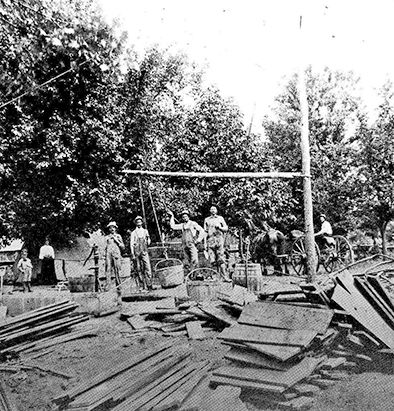
1898
Digging town well in the park. Elmer Crayne was low
bidder.
L to R in picture, Maurice Crayne,
Deltha Crayne, Elmer Crayne, Harve
Moothart, next unknown, Mack Snider. |
May 4,
1922. NEW LIGHT. Residents of Sunnyside have moonlight every night
since the light globe on the water tower has been in use. It's a 300
watt globe and is a beacon that advertises Keota's existence for miles
around.
Adding to
the above data The Eagle reporter notes that the waterworks system was
extended in 1914 or 1915, at the same time the sewer system and
disposal plant were put in. The footage of mains was more than doubled,
the hydrants more than tripled, the pump was replaced, the wooden tank
was replaced with a steel tank on the original tower, to hold about
70,000 gallons. An additional deep well was drilled in the west end but
never produced more than 20 gallons per minute and was abandoned in the
late 1930's.
The main
well in the park began to fail in 1930. Elvin Grimes drilled several
8-inch holes in the bottom of the dug well. These practically went dry
in 1936. Dewey Edwards of West Branch drilled four new wells in the
park and two in the west end before an adequate water supply was
secured. He has since drilled two more wells in the same vicinity and
one of these for several years has been the best supply the town has
ever had. There are now three wells in the park capable of producing
water. The original dug well was cased and the dug part filled with
clay and is thought to be capable of being restored to its former vigor
by modern methods. It is in the old brick pump house. A frame pump
house stands to the east about 30 feet and a well there will produce
about 40 gallons per minute. It is the main reserve well, and has an
excellent turbine pump. Another frame pump house is south of the old
well about 50 feet and the well there is the principal supply. An
excellent turbine pump produces 60 to 65 gallons per minute.
The Keota
municipal water supply has recently (1949) been approved by the State
Department of Health as meeting all requirements as to equipment,
maintenance, and purity, and it is probable the town will purchase a
standard sign from the highway department advertising the city water
here as being state-approved.
In 1958 a
new well was dug — 1756 feet deep to the Jordan Stream. This well
produced a sufficient water supply at that time, producing 300 gallons
per minute.
This water
was so hard that in 1961 it became necessary to install a softener
plant.
|
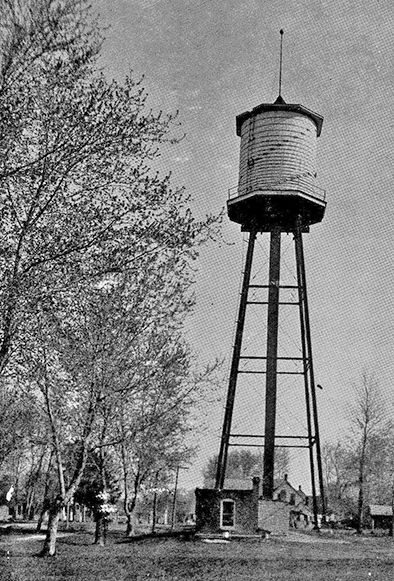
1899
Keota's old wooden water tank. |
120
|